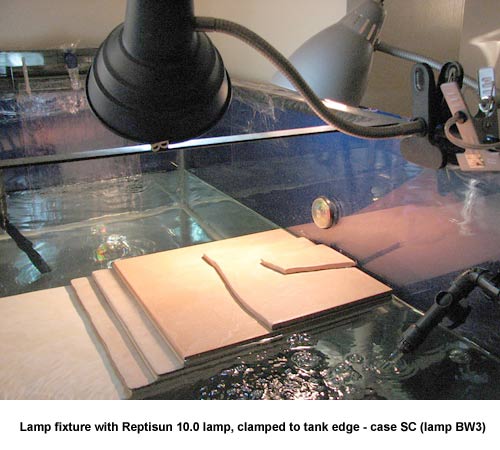|
|
This
is one case from a series of reports compiled as part
of an investigation into photo-kerato-conjunctivitis,
possibly occurring as a result of excessive low-wavelength
UVB radiation under certain brands of fluorescent
UVB lamp.
Please
do not view this one case without reference to the
whole report of which it is a part.
|
Case
History : SC
(New York, USA) - Red-eared slider turtle
(Trachemys scripta elegans)
One
male and one female red-eared slider turtle (Trachemys
scripta elegans) aged 3 years were housed in a large
purpose-built aquarium enclosure, size approximately 125
gallons (60 in. by 24 in. by 18 in.) in which they had lived
for the past 2 years.
 The
basking area (shown in Fig. 1.) was warmed by a ceramic
heater, (now replaced by a halogen flood bulb in a grey
lamp-holder, as seen in the picture) and by an UVB lamp
in a standard black household lamp-holder with a matte white
finish inside. The UVB lamp was previously an old-style
ZooMed Reptisun 10.0 Compact Lamp, replaced with a brand
new ZooMed Reptisun 10.0 Compact Lamp (new style)(Lamp BW3). The
basking area (shown in Fig. 1.) was warmed by a ceramic
heater, (now replaced by a halogen flood bulb in a grey
lamp-holder, as seen in the picture) and by an UVB lamp
in a standard black household lamp-holder with a matte white
finish inside. The UVB lamp was previously an old-style
ZooMed Reptisun 10.0 Compact Lamp, replaced with a brand
new ZooMed Reptisun 10.0 Compact Lamp (new style)(Lamp BW3).
The
UVB lamp's distance to the basking turtles was approximately
9 inches from the tip of the bulb to the top of the shell
of the largest turtle, the female. The closest she could
approach would have been 6 inches if she extended her neck
towards it; however, SC reports that both turtles usually
basked looking away from the bulb, with their backs facing
it.
Both
turtles were in good health and no eye problems had occurred
with the previous lamp. The new lamp was installed on 4th
July 2006. The light was initially in use for 12 hours a
day.
On
5th July, the female began to show symptoms of eye irritation,
and the male was affected by 8th July. By 10th July both
turtles had ceased basking and had swollen eyelids.
The
turtles were examined by a veterinary surgeon on 14th July,
and bacitracin-neomycin-polymyxin veterinary ophthalmic
ointment (Vetropolycin, Pharmaderm Animal Health)
was prescribed. No link between the new lamp and the eye
damage was suspected.
The
antibiotic eye ointment had no effect, nor did occasional
treatments with ZooMed Repti Turtle Eye Drops or ZooMed
Repti Turtle Sulfa Dip.
The
owner began to "dry dock" the turtles for 2 to 3 hours a
day, removing them from the aquarium and allowing them time
to bask out of the water, initially outdoors in natural
sunlight then after 4th September, in an indoor enclosure
under a T-Rex Active UV Heat mercury vapour lamp at a distance
of 4 feet.
The
eye problem continued for over six months. During this time
the UVB lamp was on for 8 hours a day.
Because
bright sunlight had seemed to cause some improvement, on
January 20th 2007 the ceramic heater was replaced with a
halogen light bulb and incidentally, the UVB lamp was switched
off. Within 2 days the turtles' eyes had returned to normal
and it was realised that this was the source of the problem.
The
lamp was replaced with one of the old-style ZooMed Reptisun
10.0 lamps, and no further problems were seen.
However,
in March 2007 this replacement lamp failed. The new-style
ZooMed Reptisun 10.0 lamp was re-installed but put on a
timer for only 2 hours a day. No adverse effects were observed
until one day in April when the timer did not turn off the
lamp, which was on for 8 hours.
Both
turtles developed swollen eyelids again. The lamp was removed
altogether and the problem resolved quickly.
The
turtles currently bask under an ExoTerra ReptiGlo 5.0 compact
UVB lamp and no further problems have been seen.
The
ZooMed Reptisun 10.0 lamp was submitted to FB for testing
(Lamp ref. BW3, estimated use 1500 hours).
|


















 The
basking area (shown in Fig. 1.) was warmed by a ceramic
heater, (now replaced by a halogen flood bulb in a grey
lamp-holder, as seen in the picture) and by an UVB lamp
in a standard black household lamp-holder with a matte white
finish inside. The UVB lamp was previously an old-style
ZooMed Reptisun 10.0 Compact Lamp, replaced with a brand
new ZooMed Reptisun 10.0 Compact Lamp (new style)(Lamp BW3).
The
basking area (shown in Fig. 1.) was warmed by a ceramic
heater, (now replaced by a halogen flood bulb in a grey
lamp-holder, as seen in the picture) and by an UVB lamp
in a standard black household lamp-holder with a matte white
finish inside. The UVB lamp was previously an old-style
ZooMed Reptisun 10.0 Compact Lamp, replaced with a brand
new ZooMed Reptisun 10.0 Compact Lamp (new style)(Lamp BW3).